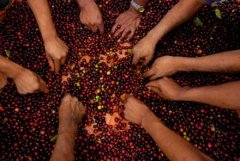Chinese coffee has experienced a low period of national macro-adjustment.
In August 1960, the CPC Central Committee put forward the eight-character policy of "readjusting, consolidating, enriching, and improving" and once again stressed the need to shorten the capital construction front. It was only after the 7,000-member meeting was held in early 1962 that the Central Committee gradually agreed. In April 1962, after the Central Financial and Economic Group approved and forwarded the report on discussing the 1962 Adjustment Plan by the Central Financial and Economic Group, it was only after the Central Committee of the CPC Central Committee approved and transferred the report on the 1962 Adjustment Plan that the problem that the infrastructure front had been too long for many years was seriously solved.

In the early 1960s, coffee was unsalable in the international market. Guangdong Land Reclamation carried out the management policy of "taking grain as the key link" and solved the problem of "grain self-sufficiency", and stopped developing coffee since 1962. Most of the original coffee plantations are in a state of desolation, with serious diseases and insect pests. All coffee gardens in the western Guangdong reclamation area were naturally eliminated, while a small part of the coffee plantations in Hainan reclamation area were preserved, and only 153.33 hectares were preserved in 1974.
From the official data of Yunnan agricultural reclamation, during the low period of coffee industry in China due to the national macro-adjustment, the author made memo statistics on the farms with more than 66.67 hectares of coffee: for example, the coffee grown in Yunnan Lujiang Farm was successfully introduced in 1955 and has developed greatly year by year, reaching 100 hectares in 1959. In the 1960s, due to market and price reasons, the farm cut coffee heavily, but in 1978 it retained only 20.33 hectares, which was already the most concentrated and largest small-grain coffee growing area in the country at that time.
The state-run farm planted 239.6 hectares in 1958 and was infected with rust in 1960. In 1961, the harvest area was only 22.67 hectares, with a total output of 1.94 tons of coffee beans and a yield of 577.5 kilograms per hectare. In the future, all of them will be scrapped except for the 0.67 hectares of experimental land of the second team.
Shuangjiang Farm of Lincang District Land Reclamation Bureau took the lead in planting 10.47 hectares of coffee in 1956. In 1959, various farms were planted one after another. By 1961, the total area reached 240 hectares, and some of them began to be put into production. In the spring of 1962, the Winter Solstice, in the spring of 1963, the reclamation area suffered a rare frost. The coffee on the farm in Meng province was reduced from 95.67 hectares to 9.4 hectares, with a loss of 92%, and the Mengsa farm was reduced from 73.67 hectares to 40 hectares. By 1970, there were only 2 hectares left in the whole reclamation area, and the original species area was almost completely scrapped.
186.67 hectares of coffee was planted on the state-run farm in Meng Province from 1959 to 1961. After it was put into production, it was scrapped in 1963 due to severe cold injury.
From 1959 to 1964, the maximum planting area of coffee in Wenshan Reclamation area of Wenshan Prefecture Land Reclamation Bureau reached 508.27 hectares, with a total production of 3.74 tons of coffee beans. Later, due to the hindrance of export, he was forced to change production.
After Yunnan's land reclamation in 1961, due to the restriction of product sales, a large number of unproduced coffee trees were destroyed. by 1970, only two farms in Lujiang and Xincheng had left 37.07 hectares. Although it has recovered somewhat since then, by 1980, the planting area of the whole reclamation area was only 78.53 hectares.
To sum up, China's coffee industry in the national macro-adjustment of China's coffee industry in the low period, the national coffee planting industry has seriously shrunk and entered the lowest period. There are four main reasons: (1) the continuous deterioration of Sino-Soviet relations and the closed-door policy and imperialist blockade at that time; (2) national macroeconomic adjustment, the focus of national agriculture is to solve the food problem related to the food and clothing of the people. (2) especially during the ten-year turbulent Cultural Revolution, the consumption of coffee was also regarded as an asset-price lifestyle, with limited sales in the domestic market, falling prices and setbacks in exports; (4) serious diseases and insect pests in coffee planting areas. seed expansion and yield are restricted.
Important Notice :
前街咖啡 FrontStreet Coffee has moved to new addredd:
FrontStreet Coffee Address: 315,Donghua East Road,GuangZhou
Tel:020 38364473
- Prev

When is the first peak period for the development of coffee planting industry in China?
By the end of the 1940s, according to recorded figures, there were 2173.33 hectares of rubber plantations on Hainan Island, with a total of 867600 rubber trees, with an annual output of 199,000 tons of dry rubber, more than 300,000 coffee plants and an annual output of 1 ton of coffee beans. According to a survey in the early 1950s, a large number of coffee was left in Fushan area of Chengmai County, with a total of 70,000 plants, including more than 40,000 plants in Daji Village and Fushan Farm (Hongguang Farm) 1
- Next

Chinese coffee has ushered in a recovery period with the country's reform and opening up.
From December 18 to 22, 1978, the third plenary session of Communist Party of China's 11th Central Committee was held in Beijing. The main achievements of this conference are: re-establishing the party's Marxist ideological line. The plenum resolutely criticized the two general erroneous policies, spoke highly of the discussion on the standard of truth, and determined to emancipate the mind, use the brain, seek truth from facts,
Related
- How did the Salvadoran coffee industry develop in Central America?
- What exactly does the golden cup extraction of coffee mean?
- The Origin of Coffee flower
- [2023 Starbucks World Earth Day] there are more meaningful things besides free Starbucks coffee!
- What kind of coffee is there in Spain? 9 Flavors of Spanish Coffee
- Aromatic African coffee| Kenya's coffee culture and historical production area
- Liberica Coffee Bean knowledge: the characteristics of Liberian Coffee beans of the three original species of Coffee beans
- The origin and formula of Spanish latte introduces the taste characteristics of Bombon coffee in Valencia, Spain.
- How to adjust the solution of over-extracted coffee
- What is the tasting period of coffee beans? What is the period of coffee and beans? How should coffee wake up and raise beans?

